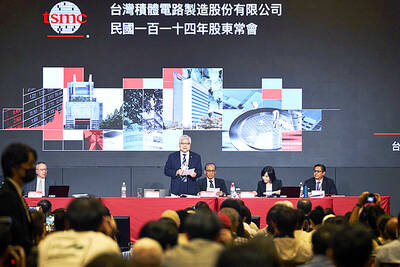Electric bikes, folding bikes and mobile devices for bicycles are among the products that are leading the trend at this year’s Taipei International Cycle Show.
“We hope to create a new era for bicycles,” Andy Su (蘇開建), chairman of Taiwan’s Darfon Innovation Corp (達瑞創新), whose e-bike won a design award at the show, told reporters on Friday.
Su said his company, a subsidiary of Darfon Electronic Corp (達方電子) — the world’s leading notebook keyboard maker — had formed an e-bike research team three years ago, because it saw its advantage as an electronics company in the growing e-bike market.
About 1 million e-bikes are sold in Europe each year, Su said.
Many of the riders are women and the elderly, who might not want to pedal for long distances, he said, adding that he expects e-bikes to gradually gain popularity outside Europe, and among young people.
So far, about 5,000 orders from Europe have been placed for three e-bike models launched by the company this year, Su said, adding that he expects his company’s e-bike revenue to reach NT$100 million (US$3.3 million) this year.
However, what excites Su more is the concept e-bike — Lion X1 — newly developed by his company that won the Taipei Cycle design award in the new e-bike category this year.
The Lion X1, unlike traditional e-bikes, does not attach electric motors or batteries onto the bike, but integrates them into the frame, Su said.
He said the bike should hit the market during the second half of the year, and will sell for about 3,000 euros (US$3,870) each.
When fully charged, the e-bike can run for between 60km and 100km, Su said.
Meanwhile, Jacky Chu (朱偉誌), research and development manager at Ming Cycle Industrial Co (永祺車業), whose folding bike Strida Evo KS3 also won a Taipei Cycle design award, said sales of folding bikes at his company have been increasing annually by about 15 percent over the past six or seven years.
While many of the customers are collectors and leisure cyclists, more people are purchasing folding bikes to commute to work or school because they are easy to carry around and park in cities, Chu said.
The biggest breakthrough for the Strida Evo KS3 is that it has a cable-free gear-shifting system that allows riders to shift between three gears by pedaling backward, Chu said. The bike was launched in January.
Smartphone devices and other e-products for bicycles are also on display at the Taipei show, including a clip-on smartphone case and a wireless device that can provide real-time traffic information, route planning and path selection.
Other innovative products featured at the show include a low-winding resistant road bike for children, a whale-shaped bicycle saddle bag that uses light-emitting diode technology to ensure safer riding at night, and an airbag backpack that can be instantly filled with air to protect the rider if they fall.
The Taipei International Cycle Show closed on Saturday with the number of international buyers hitting an all-time-high of 7,131, event organizers said. The volume also marked a 10.6 percent growth compared with last year, partly as a result of an improved economy, Taiwan External Trade Development Council official Kang Yih-jyh (康益智) said.
Among the buyers from 107 countries, East Asians, mainly from China, Japan and South Korea, topped the list of visitors to the Taipei International Cycle Show, accounting for more than 50 percent of the total, he said.
Nearly 30 percent of the visitors were from Europe and North America, he said.
Although no figures were available, the organizers said prior to the show that it was expected to generate US$300 million in business.

CAUTIOUS RECOVERY: While the manufacturing sector returned to growth amid the US-China trade truce, firms remain wary as uncertainty clouds the outlook, the CIER said The local manufacturing sector returned to expansion last month, as the official purchasing managers’ index (PMI) rose 2.1 points to 51.0, driven by a temporary easing in US-China trade tensions, the Chung-Hua Institution for Economic Research (CIER, 中華經濟研究院) said yesterday. The PMI gauges the health of the manufacturing industry, with readings above 50 indicating expansion and those below 50 signaling contraction. “Firms are not as pessimistic as they were in April, but they remain far from optimistic,” CIER president Lien Hsien-ming (連賢明) said at a news conference. The full impact of US tariff decisions is unlikely to become clear until later this month

With an approval rating of just two percent, Peruvian President Dina Boluarte might be the world’s most unpopular leader, according to pollsters. Protests greeted her rise to power 29 months ago, and have marked her entire term — joined by assorted scandals, investigations, controversies and a surge in gang violence. The 63-year-old is the target of a dozen probes, including for her alleged failure to declare gifts of luxury jewels and watches, a scandal inevitably dubbed “Rolexgate.” She is also under the microscope for a two-week undeclared absence for nose surgery — which she insists was medical, not cosmetic — and is

GROWING CONCERN: Some senior Trump administration officials opposed the UAE expansion over fears that another TSMC project could jeopardize its US investment Taiwan Semiconductor Manufacturing Co (TSMC, 台積電) is evaluating building an advanced production facility in the United Arab Emirates (UAE) and has discussed the possibility with officials in US President Donald Trump’s administration, people familiar with the matter said, in a potentially major bet on the Middle East that would only come to fruition with Washington’s approval. The company has had multiple meetings in the past few months with US Special Envoy to the Middle East Steve Witkoff and officials from MGX, an influential investment vehicle overseen by the UAE president’s brother, the people said. The conversations are a continuation of talks that

CHIP DUTIES: TSMC said it voiced its concerns to Washington about tariffs, telling the US commerce department that it wants ‘fair treatment’ to protect its competitiveness Taiwan Semiconductor Manufacturing Co (TSMC, 台積電) yesterday reiterated robust business prospects for this year as strong artificial intelligence (AI) chip demand from Nvidia Corp and other customers would absorb the impacts of US tariffs. “The impact of tariffs would be indirect, as the custom tax is the importers’ responsibility, not the exporters,” TSMC chairman and chief executive officer C.C. Wei (魏哲家) said at the chipmaker’s annual shareholders’ meeting in Hsinchu City. TSMC’s business could be affected if people become reluctant to buy electronics due to inflated prices, Wei said. In addition, the chipmaker has voiced its concern to the US Department of Commerce